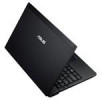Asus ASUSPRO ADVANCED B23E User's Manual for English Edition - Page 20
USB Port 3.0, Display Monitor Output, LAN Port, Modem Port
 |
View all Asus ASUSPRO ADVANCED B23E manuals
Add to My Manuals
Save this manual to your list of manuals |
Page 20 highlights
4 USB Port (3.0) The USB (Universal Serial Bus) port is compatible with USB 3.0, 2.0 or USB 1.1 devices such as keyboards, pointing devices, cameras, hard disk drives, printers, and scanners connected in a series up to 4.8Gbits/sec (USB3.0), 480Mbits/ sec (USB 2.0), and 12Mbits/sec (USB 1.1) . USB allows many devices to run simultaneously on a single computer, with some peripherals acting as additional plug-in sites or hubs. USB supports hot-swapping of devices so that most peripherals can be connected or disconnected without restarting the computer. 5 Display (Monitor) Output The 15-pin D-sub monitor port supports a standard VGA- compatible device such as a monitor or projector to allow viewing on a larger external display. 6 LAN Port The RJ-45 LAN port with eight pins is larger than the RJ-11 modem port and supports a standard Ethernet cable for connection to a local network. The built-in connector allows convenient use without additional adapters. 7 Modem Port The RJ-11 modem port with two pins is smaller than the RJ-45 LAN port and supports a standard telephone cable. The internal modem supports up to 56K V.90 transfers.The built-in connector allows convenient use without additional adapters. IMPORTANT! The built-in modem does not support the voltage used in digital phone systems. Do not connect the modem port to a digital phone system or else damage will occur to the Notebook PC. 20 Notebook PC User Manual















